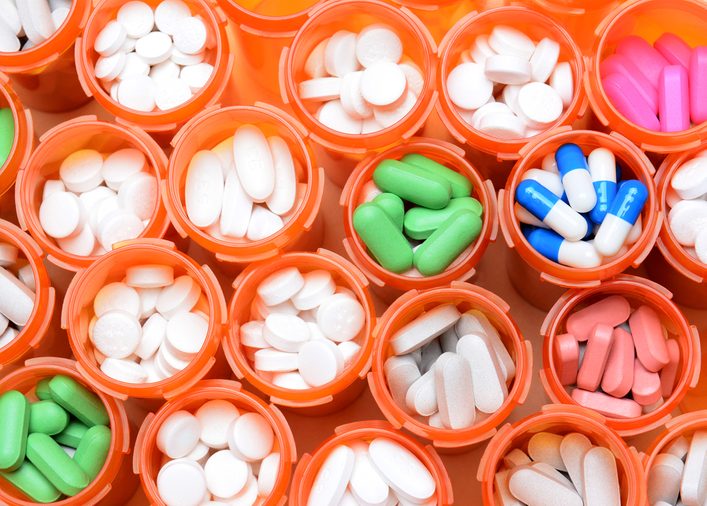The 11 Most Expensive Prescription Drugs in America
Updated: Feb. 09, 2023
Some prescription drugs cost patients more in one month than you'd pay for a new car. Here's a look at the most costly drugs on the market.

Actimmune—$52,320
Horizon Pharma manufactures this medication, which is used to treat osteoporosis and a rare immune disorder, chronic granulomatous disease. Each single-use vial of the drug costs $4,360, and most patients use 12 vials per month. According to a Horizon Pharma spokesperson, the average net price for Actimmune is $24,000 per month with available discounts and rebates, and patient assistance programs are in place to help those who can’t afford the medication to receive it. And insurance may help with the cost. “Drugs like these are often—but not always—covered by insurance,” says Doug Hirsch, co-founder, co-CEO of GoodRx. “You’ll first have to spend your own money up to your deductible before the coverage kicks in, which can often be thousands of dollars. Then, these drugs are often covered by ‘coinsurance’ instead of a flat copay, meaning you’ll pay some percentage of the cost of this drug—even 10 percent of a $40,000 drug is $4,000.” Although other Rx medications may have these issues, ACTIMMUNE does not, and Horizon has patient support and assistance in place so that, where applicable, patients are able to receive Actimmune regardless of their ability to pay, according to Amanda Phraner, Senior Manager of Public Relations and Social Media for Horizon.
Daraprim—$45,000
Daraprim had cost $13.50 per pill before pharma bad boy Martin Shkreli came on the scene and jacked the price up to $750 per pill. Though the price has since decreased slightly, the list price for a one-month supply still hovers around $45,000. Daraprim is usually given to AIDS and transplant patients to reduce the odds of an infection and to treat toxoplasmosis in otherwise healthy patients.
Cinryze—$44,140
Cinryze treats a rare condition called hereditary angioedema, which causes swelling in the hands, face, and throat. Because it is such a rare condition, there is no viable alternative treatment, unfortunately. “Most very expensive drugs do not have alternatives, thus the manufacturer can charge whatever they like,” Hirsch says. “For drugs made for rare conditions, there simply isn’t enough market demand for other manufacturers to compete.”
Chenodal—$42,570
Martin Shkreli struck again with Chenodal, increasing the cost of this medication that dissolves gallstones fivefold, to $473 per tablet. Some patients may take as many as 210 tablets per month. If you’re faced with a high-price medication, look for ways to offset the cost, such as asking your doctor for samples. “You may want to consider the use of a manufacturer copay card, although they aren’t a perfect solution as they can be limited,” Hirsch says. “There are many patient assistance programs to offset the cost, although they also have limitations.”
Myalept—$42,137
This drug is the only option available to treat the disease generalized lipodystrophy, characterized by an almost complete absence of body fat and the inability to break down sugar or fat. Most patients have to use 10 vials of Myalept every month, at $4,213 per vial.
H.P. Acthar—$38,892
A single vial of this medication costs more than $38,000—even though it was only $40 back in 2001. It’s a medication that can be used to treat a multitude of illnesses, including lupus, psoriatic arthritis, and rheumatoid arthritis.
Juxtapid—$36,988
Each pill of Juxtapid costs $1,321—and patients take 28 of them every month. Aegerion Pharmaceuticals produces the medication as a treatment for a gene mutation called homozygous familial hypercholesterolemia that can cause cardiovascular disease.
Firazyr—$32,468
Firazyr is manufactured by Shire, just like Cinryze, and both medications are used to treat the same illness—the severe swelling of hereditary angioedema. Firazyr is taken at the onset of an attack of the disease, and most patients suffer two to four attacks per month. That price is for just three syringes of Firazyr.
Harvoni—$31,500
Harvoni is medication for people with Hepatitis C. It’s one of the few medications on the most expensive medications list for which there’s actually an alternative medication available. “Some medications have similar alternatives that may be a viable option,” Hirsch says. “Just because an alternative is available doesn’t mean that your insurance company will cover it, but it never hurts to ask.”
Cuprimine—$31,426
Cuprimine is nearly 50 years old; it helps reduce copper buildup that is a hallmark of Wilson’s Disease. Patients need to take one $261.89 tablet after every meal. The price of this medication has been a subject of debate in Congress, as part of an ongoing concern over drug prices.
Sovaldi—$28,000
Sovaldi is used to treat Hepatitis C, and most patients need to take it for 12 weeks. It costs $1,000 per tablet. How do pharmaceutical manufacturers justify these prices? “Pharmaceutical manufacturers spend millions of dollars in research and development for medicines before they ever see any income,” Hirsch says. “Manufacturers typically say that these prices justify their large investments, and often these prices are less than the cost of alternative treatments like surgery or long-term care.” Here are the top secrets pharmacists won’t tell you. Including how Amazon’s new prescription plan can save you lots on some of your steepest prescriptions.
